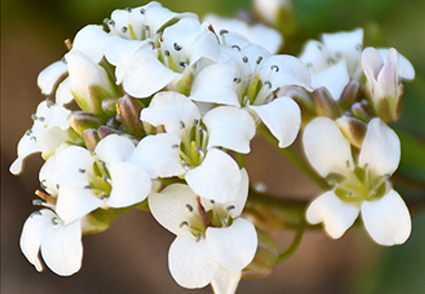Abstract
The genus Ivania is endemic to the Andes in Central Chile and comprises two species of range-restricted perennial herbs. Ivania juncalensis was described based on a single herbarium specimen collected in 1976, at a high elevation in the Río Juncal watershed. Given that the population site and status were unknown for more than 30 years, this species was considered potentially extinct. In this article we report the rediscovery of I. juncalensis in the Andes of Valparaiso region. Additionally, we provide an expanded description and new information about its distribution, habitat, ecology, and conservation status.
References
Al-Shehbaz, I.A. (2012) Dicotyledoneae, Brassicaceae. In: Anton, A.M. & Zuloaga, F.O. (Eds.) Flora Argentina. Flora vascular de la República Argentina, Vol. 8. Instituto de Botánica Darwinion; Instituto Multidisciplinario de Biología Ambiental, Argentina. https://doi.org/10.2307/j.ctt16vj2g8
Appel, O. & Al-Shehbaz, I.A. (2003) Cruciferae. In: Kubitzki, K. & Bayer, C. (Eds.) Flowering Plants, Dicotyledons. The Families and Genera of Vascular Plants, Vol 5. Springer, Berlin, Heidelberg. https://doi.org/10.1007/978-3-662-07255-4_17
Boelcke, O. & Martínez-Laborde, J.B. (1994) Cruciferae. In: Kiesling, R. (Ed.) Flora de San Juan, República Argentina, Vol. 1. Vazquez Mazzini Editores, Buenos Aires.
Cabrera, A.L. (1954) Las especies del género Nardophyllum. Notas Museo La Plata, Botánica 17: 55–66.
Don, D. (1832) Descriptive catalogue of the Compositae contained in the herbarium of Dr. Gillies: with some additions from other sources. Philosophical Magazine, or Annals of Chemistry, Mathematics, Astronomy, Natural History and General Science 11: 387–392.
Gandoger, M.M. (1913) Manipulus plantarum novarum præcipue Americæ australioris (Suite). Bulletin de la Société Botanique de France 60: 22–29. https://doi.org/10.1080/00378941.1913.10836566
Gay, C. (1847) Historia Física y Política de Chile. Flora de Chile 3: 1–482.
Gillies, J. & Hooker, W.J. (1830) On the plants of the natural order Umbelliferae. Botanical Miscellany 1: 323–335.
Hooker, J.D. (1845) The Botany of the Antarctic Voyage of H.M. discovery ships Erebus and Terror in the years 1839–1843. I. Flora Antarctica 1. Lord Auckland’s Group and Campbell Island. 208 pp. https://doi.org/10.5962/bhl.title.16028
IUCN (2012) IUCN Red List Categories and Criteria. Version 3.1, second edition. IUCN, Gland and Cambridge, 32 pp.
Johnston, I.M. (1929) Papers on the Flora of northern Chile. Contributions from the Gray Herbarium of Harvard University 85: 1–17. https://doi.org/10.5962/p.332449
Linné, C. (1753) Species plantarum. Tomus II, Laurentii Salvii. Stockholm, Sweden. 1200 pp.
Luebert, F. & Pliscoff, P. (2012) Variabilidad climática y bioclimas de la Región de Valparaíso, Chile. Investigaciones geográficas 44: 41–56. https://doi.org/10.5354/0719-5370.2012.26408
Luebert, F. & Pliscoff, P. (2017) Sinopsis bioclimática y vegetacional de Chile: segunda edición. Editorial Universitaria. Santiago, Chile, 381 pp.
Mittermeier, R.A., Turner, W.R., Larsen, F.W., Brooks, T.M. & Gascon, C. (2011) Global biodiversity conservation: the critical role of hotspots. In: Biodiversity hotspots. Springer, Berlin, Heidelberg, pp. 3–22. https://doi.org/10.1007/978-3-642-20992-5_1
Myers, N., Mittermeier, R.A., Mittermeier, C.G., Da Fonseca, G.A. & Kent, J. (2000) Biodiversity hotspots for conservation priorities. Nature 403 (6772): 853–858. https://doi.org/10.1038/35002501
Pliscoff, P., Arroyo, M.T.K. & Cavieres, L. (2012) Changes in the main vegetation types of Chile predicted under climate change based on a preliminary study: models, uncertainties and adapting research to a dynamic biodiversity World. Anales Instituto Patagonia (Chile) 40 (1): 81–86. https://doi.org/10.4067/S0718-686X2012000100010
Prantl in Engler & Prantl (1891) Tribe Thelypodieae. Nat. Pflan-zenfam 3 (2): 155.
Ravenna, P. (1981) Taxonomical notes on the Chilean Cruciferae. Nordic Journal of Botany 1 (2): 140–142. https://doi.org/10.1111/j.1756-1051.1981.tb00686.x
Rodríguez, R., Marticorena, C., Alarcón, D., Baeza, C., Cavieres, L., Finot, V.L., Fuentes, N., Kiessling, A., Mihoc, M., Pauchard, A., Ruiz, E., Sánchez, P. & Marticorena, A. (2018) Catálogo de las plantas vasculares de Chile. Gayana Botánica 75 (1): 1–430. https://doi.org/10.4067/S0717-66432018000100001
Salariato, D.L., Zuloaga, F.O. & Al-Shehbaz, I.A. (2013) Molecular phylogeny of Menonvillea and recognition of the new genus Aimara (Brassicaceae: Cremolobeae). Taxon 62 (6): 1220–1234. https://doi.org/10.12705/626.6
Scherson, R.A., Thornhill, A.H., Urbina-Casanova, R., Freyman, W.A., Pliscoff, P.A. & Mishler, B.D. (2017) Spatial phylogenetics of the vascular flora of Chile. Molecular Phylogenetics and Evolution 112: 88–95. https://doi.org/10.1016/j.ympev.2017.04.021
Schulz, O.E. (1924) Cruciferae-Sisymbrieae. In: Engler, A. (Ed.) Pflanzenreich IV. 105 (Heft 86). Verlag von Wilhelm Engelmann Leipzig 388 pp.
Schulz, O.E. (1932) Cruciferae variae. In: Notizblatt des Botanischen Gartens und Museums zu Berlin-Dahlem. pp. 389–392. https://doi.org/10.2307/3994734
Schulz, O.E. (1933) Über verschiedene Cruciferen. Repertorium novarum specierum regni vegetabilis 33 (8–17): 183–191. https://doi.org/10.1002/fedr.19330330807
Toro-Núñez, O., Al-Shehbaz, I.A. & Mort, M.E. (2015) Phylogenetic study with nuclear and chloroplast data and ecological niche reveals Atacama (Brassicaceae), a new monotypic genus endemic from the Andes of the Atacama Desert, Chile. Plant Systematics and Evolution 301 (5): 1377–1396. https://doi.org/10.1007/s00606-014-1157-y
Urbina-Casanova, R., Saldivia, P. & Scherson, R.A. (2015) Consideraciones sobre la sistemática de las familias y los géneros de plantas vasculares endémicos de Chile. Gayana Botánica 72 (2): 272–295. http://dx.doi.org/10.4067/S0717-66432015000200011
Warwick, S.I., Sauder, C.A. & Al-Shehbaz, I.A. (2011) Systematic position of Ivania, Scoliaxon, and Phravenia (Brassicaceae). Taxon 60 (4): 1156–1164. https://doi.org/10.1002/tax.604017


